Hai mai provato a caricare un file sul tuo sito WordPress e ti sei scontrato con un muro? È super frustrante quando non riesci a caricare quell'immagine, plugin o tema di cui hai bisogno. I nostri lettori ci chiedono spesso aiuto con i problemi di caricamento dei file perché possono rallentare il tuo flusso di lavoro.
A volte, questi limiti di caricamento dei file possono impedirti inaspettatamente di aggiungere contenuti alla tua libreria multimediale o di installare quei plugin e temi più grandi di cui hai bisogno. È come essere bloccati con le mani legate. Ed è ancora più fastidioso quando non sai come risolverlo!
Ma non preoccuparti, siamo qui per aiutarti. Amiamo che WordPress sia una piattaforma così configurabile e ci sono spesso più modi per risolvere lo stesso problema.
In questa guida, ti mostreremo i modi più semplici per aumentare la dimensione massima di caricamento dei file in WordPress. Ti aiuteremo a superare queste limitazioni in modo che tu possa tornare a fare ciò che ami: gestire il tuo sito web!
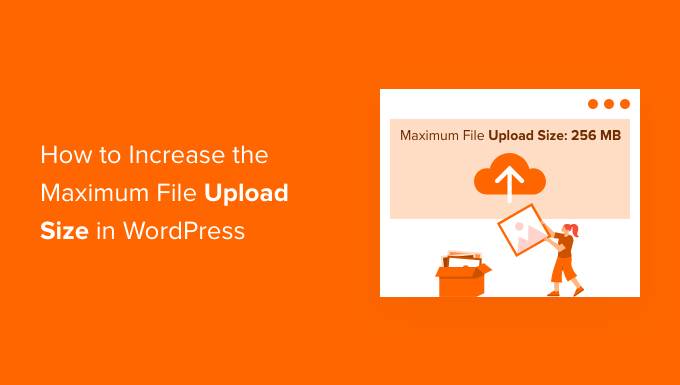
Perché aumentare la dimensione massima di caricamento dei file in WordPress?
Il tuo provider di hosting WordPress imposterà una dimensione massima predefinita di caricamento dei file quando ti iscrivi e installerai WordPress. Il tuo provider di hosting definisce questo limite, e di solito varia da 2 MB a 500 MB.
Per la maggior parte dei proprietari di siti web WordPress, questo limite sarà più che sufficiente.
Tuttavia, ci sono momenti in cui dovrai aumentare questo limite per evitare errori di caricamento.
Ad esempio:
- Gestisci un sito web di fotografia e devi caricare immagini di grandi dimensioni.
- Il tuo portfolio di design o fotografia contiene immagini di grandi dimensioni.
- Vuoi installare un tema o un plugin WordPress più grande.
- Vuoi vendere prodotti digitali come eBook, foto, video e altro.
- Aggiorni regolarmente i contenuti e aggiungi audio, foto e altro che vanno oltre il limite attuale.
Detto questo, ti mostreremo come aumentare la dimensione massima di caricamento dei file sul tuo sito WordPress.
Nota: Tieni presente che la visualizzazione di molti file di grandi dimensioni sul tuo sito web può rallentarne seriamente la velocità e le prestazioni. Ecco perché in genere consigliamo di non caricare mai video su WordPress.
Poiché la maggior parte degli utenti ha configurazioni di hosting WordPress diverse, copriremo quanto segue:
- Come controllare il limite massimo di dimensione di caricamento dei file in WordPress
- Metodo 1: Contatta il tuo provider di hosting WordPress
- Metodo 2: Crea o modifica un file php.ini esistente
- Metodo 3: Aggiungi codice al file functions.php del tuo tema WordPress
- Metodo 4: Aggiungi codice al tuo file .htaccess
- Method 5: Use a WordPress Plugin to Increase File Upload Size
Come controllare il limite massimo di dimensione di caricamento dei file in WordPress
WordPress mostrerà automaticamente il limite massimo di dimensione di caricamento dei file quando carichi immagini o altri media.
Per verificarlo, vai semplicemente su Media » Aggiungi nuovo nel tuo pannello di amministrazione di WordPress e vedrai il limite massimo di dimensione del file caricabile per il tuo sito WordPress.
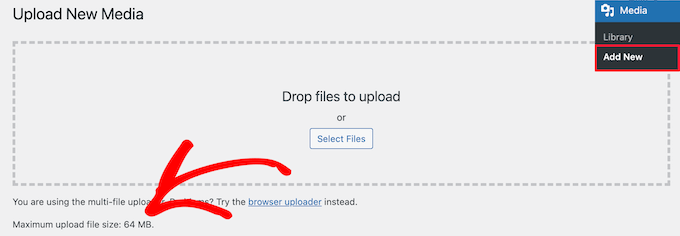
Ora che sai come trovare il limite di dimensione, ti mostreremo come aumentare la dimensione massima di caricamento in WordPress.
Metodo 1: Contatta il tuo provider di hosting WordPress
Uno dei modi più semplici per aumentare la dimensione massima di caricamento dei file in WordPress è contattare il tuo provider di hosting WordPress.
Questo è un compito relativamente semplice per il loro team di assistenza clienti e può essere fatto in un paio di minuti.
Per i principianti, questo può essere molto più facile che aggiungere codice a WordPress e modificare i file del server.
Vai semplicemente sul sito web del tuo provider di hosting, come Bluehost, ed effettua l'accesso.
Quindi, fai clic sull'icona ‘Chat’ in fondo allo schermo. Puoi quindi chiedere al personale di supporto di aumentare la dimensione del caricamento dei file sul tuo sito WordPress.
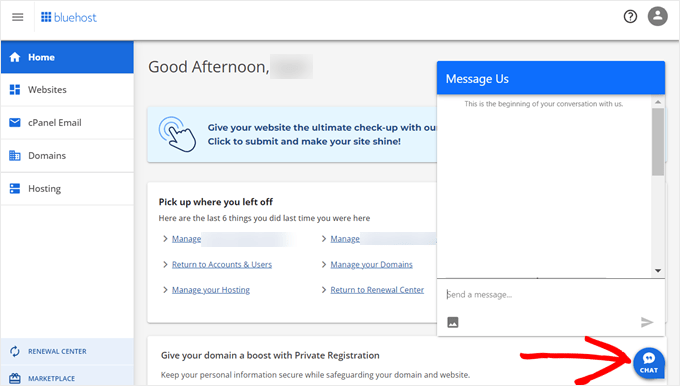
Puoi anche contattare il supporto dalla dashboard del tuo account di hosting.
Metodo 2: Crea o modifica un file php.ini esistente
Un altro modo per aumentare la dimensione massima di caricamento dei file è creare o modificare un file chiamato php.ini. Questo file controlla molte impostazioni per il tuo ambiente di hosting WordPress.
La maggior parte dei provider di hosting WordPress come Bluehost dispone di un cPanel intuitivo per aiutarti a gestire il tuo sito web.
Se il tuo web host dispone di una dashboard cPanel, puoi aumentare la dimensione di caricamento dei file tramite gli strumenti integrati.
Nota: Quanto segue è tratto dal cPanel di Bluehost. Tuttavia, la maggior parte dei provider di hosting condiviso avrà passaggi simili.
Troverai un pulsante cPanel in fondo alla scheda Hosting in Bluehost.
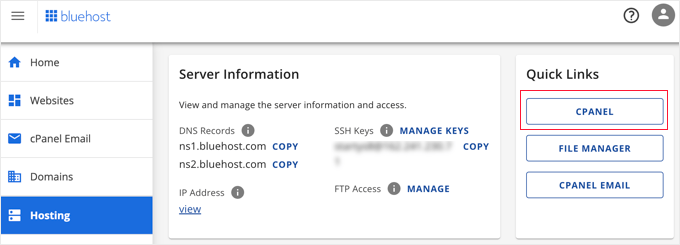
Facendo clic su questo pulsante si aprirà la tua dashboard cPanel.
Ora devi scorrere verso il basso fino alla sezione Software e fare clic su ‘MultiPHP INI Editor’.
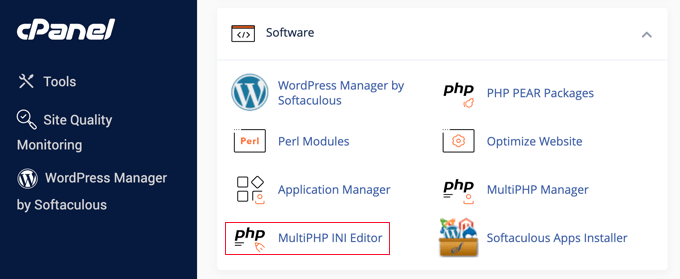
Successivamente, scorri verso il basso fino alla sezione etichettata ‘upload_max_filesize’ e inserisci una nuova dimensione massima del file nella casella.
Quindi, fai clic sul pulsante ‘Applica’.
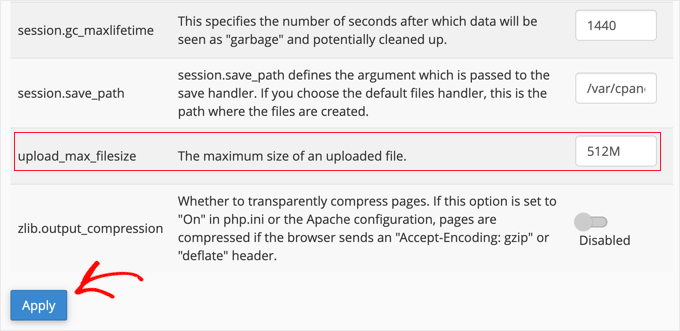
In alternativa, puoi fare clic sulla scheda del menu ‘Modalità Editor’, e quindi puoi modificare direttamente la dimensione massima di caricamento dei file nell'editor.
Devi modificare la sezione ‘upload_max_filesize’ per aumentare la dimensione di caricamento dei tuoi file.
Una volta terminato, fai semplicemente clic sul pulsante ‘Salva’.
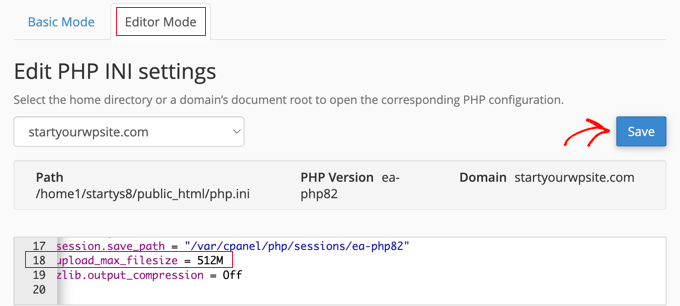
Modifica php.ini aggiungendo codice
Se il tuo attuale provider di hosting non offre l'opzione cPanel, dovrai modificare questo file manualmente.
Per fare ciò, puoi utilizzare un client FTP o l'opzione del file manager nel pannello di controllo del tuo hosting WordPress.
Se stai utilizzando l'hosting condiviso, potresti non vedere il file php.ini nella tua directory di hosting. Se non ne vedi uno, crea semplicemente un file chiamato php.ini e caricalo nella tua cartella principale.
Quindi, aggiungi il seguente snippet di codice al file:
upload_max_filesize = 256M
post_max_size = 256M
max_execution_time = 300
Puoi modificare il limite di '256M' con la dimensione del file di cui hai bisogno per il tuo blog WordPress.
Metodo 3: Aggiungi codice al file functions.php del tuo tema WordPress
Questo metodo prevede l'aggiunta di codice al tuo file functions.php nel tuo tema WordPress.
Invece di modificare direttamente il file, ti consigliamo di utilizzare WPCode. È il miglior plugin per snippet di codice che ti consente di aggiungere codice al tuo sito web senza romperlo.
Se non l'hai mai fatto prima, consulta la nostra guida per principianti su come aggiungere codice personalizzato in WordPress.
Per prima cosa, devi installare il plugin gratuito WPCode. Per maggiori dettagli, consulta la nostra guida passo passo su come installare un plugin di WordPress.
Dopo l'attivazione, dovresti navigare su Snippet di codice » + Aggiungi snippet.
Dovrai passare il mouse sull'opzione ‘Aggiungi il tuo codice personalizzato (Nuovo snippet)’ e quindi fare clic sul pulsante ‘+ Aggiungi snippet personalizzato’.

Successivamente, devi scegliere ‘Snippet PHP’ come tipo di codice dall'elenco delle opzioni che appaiono.

Nella schermata seguente, inserisci un nome per il tuo nuovo snippet, che può essere qualsiasi cosa per aiutarti a ricordare a cosa serve il codice.
Quindi, puoi copiare e incollare il seguente snippet di codice sotto ‘Anteprima codice’. Assicurati di cambiare ‘256M’ con la dimensione massima del file di cui hai bisogno:
@ini_set( 'upload_max_size' , '256M' );
@ini_set( 'post_max_size', '256M');
@ini_set( 'max_execution_time', '300' );
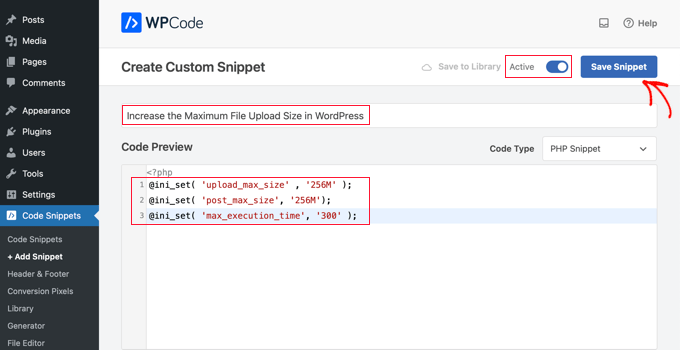
Infine, sposta l'interruttore in alto su ‘Attivo’ e quindi fai clic sul pulsante ‘Salva snippet’. Il codice verrà ora eseguito sul tuo sito web.
Metodo 4: Aggiungi codice al tuo file .htaccess
Un altro modo per aumentare la dimensione massima del file è modificando il file .htaccess. Questo file controlla le impostazioni di configurazione di alto livello per il tuo sito web.
Per fare ciò, devi accedere al server del tuo sito web tramite FTP. Se non l'hai mai fatto prima, consulta la nostra guida su come usare FTP per caricare file su WordPress per principianti.
Dopodiché, devi individuare il tuo file .htaccess nella cartella principale del tuo sito web.

Se non riesci a trovare il tuo file .htaccess, potrebbe essere nascosto dal tuo file manager o client FTP. Per saperne di più, consulta la nostra guida su perché non riesci a trovare il file .htaccess sul tuo sito WordPress.
Successivamente, devi aggiungere il seguente snippet di codice al tuo file .htaccess:
php_value upload_max_filesize 256M
php_value post_max_size 256M
php_value max_execution_time 300
php_value max_input_time 300
Per aumentare ulteriormente la dimensione massima di caricamento dei file, cambia semplicemente '64M' con la dimensione che desideri.
Metodo 5: Usa un plugin WordPress per aumentare la dimensione di caricamento dei file
Un altro modo per aumentare il limite massimo di caricamento dei file è utilizzare il plugin WP Increase Upload Filesize. Se non ti senti a tuo agio nell'aggiungere codice a WordPress, questa potrebbe essere una buona opzione per te.
La prima cosa da fare è installare e attivare il plugin. Per maggiori dettagli, consulta la nostra guida su come installare un plugin di WordPress.
Dopo l'attivazione, naviga su Media » Aumenta Limite Caricamento nel tuo pannello di amministrazione di WordPress.
Questo ti porterà a una schermata in cui puoi selezionare una nuova dimensione di caricamento file nel menu a discesa 'Scegli Dimensione Massima Caricamento File'.
Quindi, fai clic sul pulsante 'Salva Modifiche'.

Nota: La dimensione massima di caricamento dei file sarà impostata dal tuo provider di hosting. Se hai bisogno di un limite di dimensione file superiore a quello elencato nel menu a discesa, devi contattare il tuo provider di hosting e chiedere di aumentare il limite.
Tutorial video
Se non ti piace seguire istruzioni scritte, puoi guardare il nostro tutorial video invece:
Speriamo che questo articolo ti abbia aiutato ad aumentare la dimensione massima di caricamento dei file in WordPress. Potresti anche voler consultare la nostra guida su come aggiungere tipi di file aggiuntivi da caricare in WordPress e le nostre scelte di esperti di plugin e suggerimenti per migliorare l'area di amministrazione di WordPress.
Se ti è piaciuto questo articolo, iscriviti al nostro canale YouTube per tutorial video su WordPress. Puoi anche trovarci su Twitter e Facebook.





Sushil Kumar
Grazie Yasir Imran, funziona per me tramite .htaccess
Pedro Viana
Regole .htaccess! grazie.
Amit Kumar Gupta
Articolo molto utile per me. Grazie wpbeginner
Steve S
Ho trovato una soluzione che non comporta modifiche a php.ini, .htaccess, functions.php o altri file di sistema. Tutto quello che ho fatto è stato quanto segue:
* Carica il file via FTP su /wp-content/uploads/anno/mese/nomefile.mp4
* Nuovo Post –> Aggiungi Media –> Inserisci da URL
* Copia e incolla l'URL appropriato in base a dove hai caricato il file.
* Premi Inserisci nel Post. Fatto.
kenny
Perfetto! ps se stai inserendo un'immagine per lo sfondo di una diapositiva in Slider Revolution, usa l'opzione 'URL esterno'
vic
il .htaccess ha funzionato bene per me. grazie mille
Anchal Singh
il mio sito web ha lo stesso problema ma grazie a questo post ora funziona perfettamente
Matt
Grazie. Vorrei anche sapere come creare un portale web usando WordPress. Qualsiasi informazione da parte tua sarà molto apprezzata.
marta
Thanks. For me htaccess Method did his job
Rifqi Arief
Grazie Bro, Funziona sul mio hosting gratuito tramite .htacess
RT
Prova anche i passaggi seguenti dopo aver creato il php.ini
(1) Vai su I miei siti -> Amministrazione di rete -> Impostazioni dalla dashboard di amministrazione di WordPress.
(2) Deseleziona la casella per “Spazio di caricamento del sito: Limita la dimensione totale dei file caricati a 10 MB” e Salva le modifiche.
(3) Fatto.
Cordiali saluti,
-RT
Suika
Grazie, avevo dimenticato che c'era un'impostazione per quello.
Abhishek
Sono su hosting goddady, nessuna delle 3 soluzioni ha funzionato per me.
Ma alcuni utenti hanno segnalato che il file .user.ini ha funzionato per loro su goddady.
Qualcuno può dirmi dove mettere questo file?
Ho provato la cartella principale e la cartella wp-admin, niente ha funzionato.
Raman Gutyan
Il metodo htaccess funziona benissimo sul mio localhost.
Grazie per aver condiviso.
DVR
Se stai incontrando un ostacolo. Vai al tuo host. Impostazioni avanzate per PHP. Scansiona il codice cercando max upload & file size. Cambialo alle impostazioni richieste.
Fatto.
Vedi la risposta di NICOLAS sopra.
martin kendall
Ciao DVR, ho provato di tutto e niente ha funzionato, con quello che era stato pubblicato qui. Ho provato più volte in ogni modo per farlo funzionare. Niente, ma il tuo post mi ha portato alla risposta corretta. Grazie mille per questo.
Ok, ecco cosa ho fatto, ho effettuato l'accesso al mio server host, dove si trova il mio sito web. Il server host funziona su cPanel e il tema è paper_lantern. Non dovrebbe importare quale sia il tuo server o il tema. Se non hai accesso a quest'area, dovrai chiedere al tuo host di apportare le modifiche contattando il tuo supporto tecnico.
Nel pannello troverai categorie come = file, database, domini, email ecc. e quello che stai cercando è software, sotto software / app cerca multiPHP INI Editor o qualcosa di simile. Sarà diverso su altre piattaforme ma dovrebbe essere in quell'area. Quello che stai cercando è configurare le impostazioni di base di PHP INI o la modalità editor. Mi è stato offerto la directory principale o il nome del mio dominio. Ho scelto il nome del dominio ma forse è necessario cambiarli entrambi, ma non ne ho avuto bisogno. Ho scorrevole verso il basso fino a upload_max_filesize e l'ho cambiato in 64M ma questo non ha funzionato perché devi anche cambiare memory_limit a 64M. Devono essere la stessa cifra. e poi funzionerà.
Per quanto ho capito, quando apporti le modifiche nel codice di WordPress, le istruzioni parlano al tuo database attraverso i file PHP e istruiscono il software del server a modificare le impostazioni del database. Per qualche motivo non ha funzionato per me. Quindi questa strada bypassa quello e apporta le modifiche al software del server e non al software di WordPress. In futuro andrò per questa strada perché è stato davvero veloce. Spero che questo aiuti come ultima risorsa. Martin p.s. questo era WordPress 4.8.1 e ho scoperto che non aveva, dopo averlo caricato, alcun file PHP.INI o .htaccess. Li ho installati ma non hanno fatto alcuna differenza e o dove li ho messi.
Jeet Patel
THank you so much it’s working really
Silentnight
Grazie mille... Ho aumentato la mia dimensione di caricamento.
Gopi krishnan
Per me, questo non funziona, ma l'ho fatto nel file htaccess in questo modo,
php_value post_max_size 10M
php_value upload_max_filesize 40M
php_value memory_limit 500M
Funziona !
agnieszka00
Grazie!!!!!
Michael Serovey
Ho i miei siti web ospitati con GoDaddy e finora NESSUNO dei suggerimenti sopra ha funzionato! Ho pagato per questo plugin e ora ho buttato via i miei soldi!
Paul
Ciao,
Per evitare il limite di caricamento dei plugin, puoi semplicemente caricare il plugin con FileZilla nella tua directory dei plugin. Dopo aver caricato, puoi estrarre il file zip nel file manager e, una volta fatto ciò, il plugin sarà visibile e pronto per essere attivato nel tuo pannello admin –> plugin
Spero sia stato d'aiuto.
Saluti
Pooya
WOW! GRAZIE PAUL!!
Ha funzionato perfettamente per me!
ed è MOLTO più facile e affidabile di uno qualsiasi di quei metodi.
vai semplicemente su File Directory sotto cPanel -> Public-html -> [la tua cartella del sito] -> wp-content -> themes o plugins
Quindi carica il file zip qui ed estrailo.
accedi alla tua dashboard wp-admin. e voilà, hai il tuo tema o plugin.
Tom
Grazie al Signore (Paul) ci è voluto troppo tempo.
Nicolas
Vai al tuo pannello di controllo hosting -> Avanzate -> Impostazioni PHP -> upload_max_filesize (di solito è impostato su 2M, puoi cambiarlo fino a 8M nel mio caso... il punto è che non dovrebbe essere superiore al tuo post_max_size)
Prego!
Jake
La migliore risposta finora.
Steven Gliebe
functions.php non è il posto migliore per inserire il codice perché aumentare il limite massimo di dimensione di caricamento PHP non è correlato a un tema specifico. Gli utenti non dovrebbero comunque modificare direttamente i file del tema. wp-config.php è probabilmente un posto migliore. Il metodo .htaccess o php.ini è ancora migliore (o semplicemente chiedi all'host).
Stephanie
php.ini deve essere nella cartella wp-admin. Questo articolo afferma che deve essere nella root, cosa che ho provato ma non ha fatto alcuna differenza. Per tua informazione
Grazie per le informazioni!
Aaron
Grazie mille per la tua risposta Stephanie. Le tue informazioni erano esattamente ciò di cui avevo bisogno.
Mike Serovey
Finora, NESSUNO dei suggerimenti sopra ha funzionato. Il mio pannello di controllo NON mi permette di cambiare le Impostazioni PHP, modificare il .htaccess ha creato un errore interno del server e modificare il tema non ha funzionato. Avete altri suggerimenti?
Mike Serovey
Con l'hosting GoDaddy, ho scoperto che dovevo usare le righe di codice che qualcuno aveva pubblicato per il file .user.ini e poi aggiornare il mio browser e ricontrollare il plugin circa tre volte ciascuno prima che la cosa FINALMENTE funzionasse!
Robert
Grazie! il file ini deve essere caricato nella cartella wp-admin.
Emmanuel Parbey
Grazie.
Ha funzionato perfettamente.
Somnath
@Stephnie Grazie Mille. Funziona
Sorin
In wp-admin metti php.ini e funziona
Angel Rodriguez
Anche questo ha funzionato per me.
shemmy
grazie ..questo funziona bene
Prabhat
sì, questo è utile
Matt
Ha funzionato immediatamente! Grazie! A proposito, se qualcun altro vuole saperlo, il mio host è BlueHost e sto usando un tema Genesis.
Panagiotis Sakalakis
Usando il .htaccess ho ottenuto un errore interno, e poi ho semplicemente rimosso il codice e si è risolto. Dopo di che, ho creato un file php.ini in /public_html/wp-admin, ho incollato il codice e l'ho salvato. Ora tutto funziona a meraviglia e posso caricare i miei file senza problemi.
Umesh Shejole
Sì, Utile……
Subin Babukuttan
htaccess ha funzionato bene. grazie per il post
hol
Ciao
Qualcuno sa perché se il file PHP.INI viene modificato come menzionato, quando il file è completato al 100% non succede nulla e viene visualizzato un errore http?
Posso caricare file di piccole dimensioni e video di piccole dimensioni.
Non posso caricare nulla di più grande di, diciamo, 200 MB
Avevo questa funzionalità funzionante e che accettava file più grandi, poi ho effettuato un ripristino del sito web.
Ho modificato il PHP.INI…
C'è qualche motivo per cui solo i file di grandi dimensioni non funzionano?
devo modificare il file hta.access?
grazie
Ian
Il metodo .htaccess ha funzionato per l'hosting grid di Media Temple, altri non l'hanno influenzato, nel caso in cui qualcuno si stia chiedendo...
Jay
SE ANCORA NON FUNZIONA NULLA..
(Nel mio caso il problema era con WP MULTISITES)..,
PER PRIMA COSA CONTROLLA QUANTO SEGUE:
1. controlla i limiti del tuo hosting (anche se questo non era il mio problema) assicurati che il tuo hosting consenta il limite che stai cercando di impostare, ad esempio su un hosting condiviso potresti trovare che il massimo è 64M.
NOTA: La seguente soluzione potrebbe applicarsi anche se in WordPress, la dimensione massima del file caricato non cambia anche quando viene modificata nel file php.ini, ecc.
Il problema del caricamento massimo di 1 MB risiede nelle impostazioni predefinite di WP MULTISITES!!
Per cambiare questo, fai quanto segue per cambiare la dimensione massima del file caricato all'interno dell'amministrazione di WP:
ACCEDI AL TUO DASHBOARD DI AMMINISTRAZIONE:
1. In alto, passa il mouse su I miei siti e quindi fai clic su Amministrazione di rete.
2. A sinistra, passa il mouse su Impostazioni e quindi fai clic su Impostazioni di rete.
3. Scorri fino in fondo alla pagina e cambia la Dimensione massima file caricabile in quello che desideri in KB.
4. Fai clic su Salva modifiche.
Hope this helps
Gregg
SÌÌÌ. Grazie signore.
Milton
Grazie Jay, avevi perfettamente ragione per WP multisites
Denis
Ha funzionato per me. Il sito funzionava prima e non capivo perché non funzionasse più. È stata la mia conversione a multisite a causare il problema.
Sam
Fantastico!!! Funziona!
Adam
Grazie!!!! Accidenti, non c'è molto aiuto sulle modifiche che apporta il multisito!
Bhanu uday
Ha funzionato a meraviglia. Grazie mille.
AmanDeep Singh
Funziona!. Uso il metodo Crea o Modifica un file PHP.INI esistente e dopo aver applicato le impostazioni come menzionato nell'articolo ora sono in grado di caricare temi e plugin di grandi dimensioni. Grazie per aver condiviso la soluzione.
Judy
Sono nuovo di WordPress, di solito uso Joomla ma ho un nuovo cliente che vuole un sito WordPress. Quando provo a caricare immagini, il messaggio di WordPress era che il limite di file era 3Mb. Ho passato ore a cercare risposte sui siti web. Sto usando WAMP e localhost per creare il sito. Tramite localhost phpinfo() ho potuto verificare quale php.ini era attivo, quello in Apache. Avevo un limite di file di 64Mb ma WordPress aveva ancora un limite di 3Mb. Questo sito ha fornito le istruzioni al punto #3 per modificare il file .htaccess nella cartella di WordPress. Ho copiato e incollato il testo in questo file e HA FUNZIONATO! Grazie wpbeginner.
KenSanDiego
dimenticavo di menzionare, il mio sito WP è in una sottodirectory con un puntatore di dominio. Il php di Powweb si applica a tutto in tutte le sottodirectory. Quindi, se hai installazioni in sottodirectory, la modifica si applica a tutte le installazioni.
Ugyen Zangmo
Crea php.ini nella cartella wp-admin
Nel file inserisci le seguenti 3 righe:
upload_max_filesize = 2048M
post_max_size = 2048M
max_execution_time = 3000
Vai sul tuo sito come amministratore e controlla la pagina di caricamento nuovi media, ora dovrebbe visualizzare Dimensione massima file caricabile: 2 GB.
Grazie a Yasir Imran per aver condiviso il tuo consiglio!
Questo ha funzionato per me. Grazie James per aver condiviso il consiglio di Yasir Imran. Saluti
sadiq
non funziona ho fatto lo stesso
sul server di godaddy
Raton Miah
funziona!
Brendan
È stato un ottimo consiglio... ha funzionato per me.. grazie!
Ben
Mamma mia! Grazie mille amico, dopo l'ultimo aggiornamento di WordPress alla versione 4.3.1 la dimensione del mio upload è tornata al valore predefinito di 50 MB, anche se i miei file php.ini, .htaccess e wp-config.php non erano cambiati e riflettevano ancora una dimensione massima di upload di 512 MB! Sei un eroe!
Alain
Grazie mille!
Ho provato TUTTI e tre i metodi senza risultati.
Ho chiesto all'host web e hanno aumentato il limite a 40 MB.
Poi, finalmente, ho provato il tuo e ha funzionato fantasticamente!
dominio público
post_max_size dovrebbe essere maggiore di upload_max_filesize per lasciare spazio ad altre informazioni. I valori predefiniti sono 2 MB di dimensione massima del file e 8 MB di dimensione massima del post.
Dalla documentazione di PHP:
post_max_size integer
Imposta la dimensione massima dei dati post consentiti. Questa impostazione influisce anche sull'upload dei file. Per caricare file di grandi dimensioni, questo valore deve essere maggiore di upload_max_filesize.
Nori
Grazie per questo! Ho provato il php.ini e sono piuttosto sorpreso che abbia funzionato ed è stato così facile
Dan
Il file php.ini ha funzionato perfettamente per me. Ho semplicemente cambiato i valori esistenti in 100M. Tutto bene. Grazie per il consiglio.
James
Crea php.ini nella cartella wp-admin
Nel file inserisci le seguenti 3 righe:
upload_max_filesize = 2048M
post_max_size = 2048M
max_execution_time = 3000
Vai sul tuo sito come amministratore e controlla la pagina di caricamento nuovi media, ora dovrebbe visualizzare Dimensione massima file caricabile: 2 GB.
Grazie a Yasir Imran per aver condiviso il tuo consiglio!
Zain
Ciao,
Per favore, dimmi i nomi dei migliori temi per siti di software/download?
Sto aspettando.
Grazie,
Zain.
Markus Aurelius
Nessuno dei metodi sopra ha funzionato per me su GoDaddy, quindi ho dovuto usare .user.ini invece di php.ini e ha funzionato bene. Grazie per avermi indicato la giusta direzione!
Keith
Grazie mille. Sono su GoDaddy e questo ha funzionato mentre diversi altri metodi no.
Raj Kothari
Ciao Keith, puoi dirmi in quale cartella hai messo questo file? .user.ini
Ho bisogno di aiuto
Oliver
Grazie, .user.ini ha funzionato per me su Godaddy
sam
1:- apri la cartella “C:wampbinapacheapache2.4.9bin” e trova “php”, che è un file di configurazione, aprilo nel tuo notepad e cerca di nuovo “upload_max_filesize” e “post_max_size” e cambia entrambi e salva.
2:- apri la cartella “C:wampbinphpphp5.5.12” e trova “php” e “phpforapache”, che sono file di configurazione, aprilili entrambi nel tuo notepad e cerca di nuovo “upload_max_filesize” e “post_max_size” e cambia entrambi e salva.
3:- infine riavvia tutti i servizi di wamp e goditi... vi amo tutti
Decb
Ciao ragazzi, sono VERAMENTE nuovo a questo, ma potete dare un'occhiata a quello che vedo quando clicco per modificare il file .htaccess – dove devo aggiungere il codice? all'inizio? alla fine? Metto il cursore all'inizio e premo invio (poi lo inserisco) ??? Aiuto per favore
Gerard ONeill
Deb, non farebbe differenza dove lo aggiungi; ma assicurati che sia fuori da un blocco. Per sicurezza, aggiungilo alla fine.
Tuttavia, il modo migliore (da php5.5 in poi) è modificare il file .user.ini su base per directory. Se lo facessi nella directory di primo livello, si applicherebbe a tutte le sottodirectory (a meno che non venga sovrascritto).
http://php.net/manual/en/configuration.file.per-user.php
E ovviamente anche il php.ini a livello di sistema funziona.
BenPDX
+1 per la soluzione di Alex. Caricare la cartella php.ini nella cartella wp-admin ha funzionato per me su Lithium Hosting. Ricerca Google di 30 secondi e 1 minuto per creare un file di testo e caricarlo sul server!
Dede Erik
Ho scelto il terzo metodo e ha funzionato per me, grazie mille
Hasan Tareq
.htaccess funziona per il mio sito wpenigne
Vineesh
Ciao Alex, hai ragione. Il file php.ini dovrebbe essere aggiunto alla cartella wp-admin. Funzionerà perfettamente... grazie Alex
Rafael
Aggiungere semplicemente il file php.ini nella cartella wp admin ha funzionato perfettamente!!! grazie!
chandan
Grazie mille Alex, ha funzionato anche per me..
Tony_atf
Continuo a ricevere un errore http anche con il tuo suggerimento. Sono su GoDaddy, ho una dimensione file di 300 MB ma qualsiasi cosa superiore a 150 MB va in tilt. Viene caricato, rimane per alcuni secondi e poi viene visualizzato l'errore http. WordPress non mostra mai l'errore.
SunnyK
lo stesso per me. hai trovato una soluzione?
Staff di WPBeginner
Puoi connetterti al tuo sito web usando un client FTP e annullare le modifiche apportate.
Nitesh Magan
Ciao, ho aggiunto il primo codice al file functions del mio tema, ma ora tutto sul mio sito è diventato nero. Non riesco nemmeno ad accedere al mio wp-admin del sito!!
Aiuto per favore...
Chris
Se stai solo cercando di caricare file da solo nel pannello di amministrazione (media), crea un nuovo documento di testo normale, salvalo con qualsiasi nome (inclusa l'estensione) del file di grandi dimensioni che stai cercando di caricare. Quindi, se stai cercando di caricare "files.zip", salva un documento di testo vuoto come files.zip. Carica questo file di testo vuoto che hai appena creato in Wordpress. Quindi, vai su FTP o file manager, vai su wp-content/uploads/(qualunque sia l'anno)/(qualunque sia il mese). Dovresti trovare files.zip lì. Elimina quel file (che è solo un file di testo normale) quindi carica il vero files.zip, assicurandoti che i nomi corrispondano. Quindi, quando torni ai media, sarà il file giusto.
Yasir Imran
Ho provato il metodo htaccess e ho riscontrato un errore interno del server 500, quindi ho inserito php.ini con le 3 righe fornite nella directory principale, di nuovo non ha funzionato. Poi l'ho inserito nella cartella wp-admin e ha funzionato. Penso che l'autore dovrebbe menzionarlo.
Alexandre
Questo ha funzionato per me mentre tutto il resto aveva fallito. Grazie per aver condiviso.
Mel
Ho avuto esattamente la stessa esperienza e questo ha funzionato per me. Grazie Yasir!
Les B
Grazie Yasir Imran... il tuo metodo funziona dove tutti gli altri, incluso .htaccess, falliscono!
(Il file php.ini deve essere nella cartella wp-admin.)
Les